Prevention & Control of Invasive Weeds
The historic 2020 Labor Day Fires impacted approximately 44% of the North Santiam Watershed, greatly impacting the native plant communities we value in the Santiam Canyon. Even after 3 years, our community continues to recover and rebuild from the devastation. We like to continue to educate the opportunity that this event created, now and for many years to come: invasive weeds. With efforts to restore and rebuild, we are left with disturbed and exposed landscapes and soils. With these exposed landscapes, there is a high risk of unwanted weed infestations.
The seeds from invasive weeds spread easily by way of wind, birds, animals, vehicles, and equipment. Once introduced, many of the noxious and invasive plant species have the potential to outcompete our native plant communities.
One way to help stop the spread is through Early Detection and Rapid Response process, or EDRR. This strategy is used to identify and then eradicate weeds as quickly as possible. Weed treatments are most cost effective when populations are small. In the North Santiam Watershed, experts have identified the following weeds as high priority for treatment:
- False Brome
- Garlic Mustard
- Italian Thistle
- Spotted, Meadow and Diffuse Knapweed
- Yellow Archangel
- Knotweeds
These are invasive weeds that we can help you with. From now until August 2024, we have funding to assist with EDRR surveys, and treatment of the weeds listed above!
Common Misconceptions
Weeds are always a problem, so what’s the urgency?
Post-fire soils are much more susceptible to being taken over by invasive plant species. The risks of new infestations are high, especially in areas where invasive species were absent before the fire. In addition, with so much clean up, logging and rebuilding taking place, there are now new areas for weeds to grow. Also, with so much new soil disturbance, dormant weed seeds may now be in ideal conditions to grow.
All the weeds burnt up in the fire, so they can’t come back, right?
Many weeds did not die in the fire. Existing invasive plants may have only been top killed in the fire. Roots and seeds may have survived. Soil is a great insulator and in most areas where the soils were only moderately impacted large invasive plant seed banks may still exist. For example, Scotch broom seeds can live dormant in the soil for up to 80 years. Ground disturbing activities most likely have brought these seeds to the surface.
Species of Concern in Fire Impacted Areas & Common Control Methods
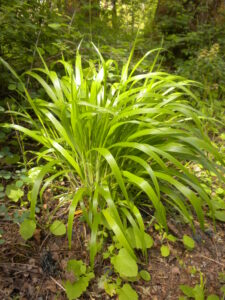 False Brome
False Brome
False Brome (Brachypodium sylvaticum)
False brome is a perennial bunchgrass native to Eurasia and North Africa that generally stays green throughout the year. It has spread extensively in areas of western Oregon. It is highly invasive in shaded woodlands, open prairies, and roadsides and can out-compete native forest understory and grassland vegetation.
Prevention: Seeds of false brome can be carried on shoes and vehicles, so special care should be taken to clean off after entering areas infested with this plant. Watch for new patches of this plant especially after other grasses have started to turn brown (August to November or later).
Treatments: Small infestations can be dug up. Herbicides can be used from mid-summer through fall or after the rainy season begins. Follow the product label and all laws and regulations regarding herbicide use on the site. To reduce the amount of herbicide used, a multi-year mowing regime can be used to exhaust the seed bank before starting herbicide treatment. A combination of mowing in early July followed with a fall treatment of herbicide is also effective.
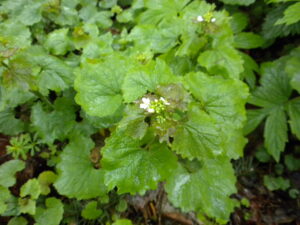 Garlic Mustard
Garlic Mustard
Garlic Mustard (Allaria petiolata)
Introduced from Europe originally as a food plant, this species is now a serious concern in forests across North America. Garlic mustard is an invasive non-native biennial herb that spreads by seed. Although edible for people, it is not eaten by local wildlife or insects.
We currently do not know of any locations of this plant in the North Santiam Watershed, but it is a problem in Clackamas County and in the Portland metro area. It is especially important to eradicate any garlic mustard plants that might be found within the fire area.
Treatments: Hand-pulling individual plants is effective if the entire root is removed. Flowering or seeding plants must be put in a bag and discarded in the garbage. Carefully and thoroughly clean off boots, clothes and tools before leaving the area to avoid carrying the tiny seeds to new sites. Herbicide may be needed for large, dense infestations and should be applied in the spring or fall on seedlings and rosettes, with care taken to avoid native and other desirable plants. Follow the product label and all laws and regulations regarding herbicide use on the site.
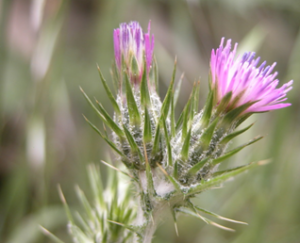 Italian Thistle
Italian Thistle
Italian Thistle (Carduus pycnocephalus)
Native to the Mediterranean, southern Europe, and North Africa to Pakistan, Italian thistle is now widespread in temperate zones and a major pest in Australia, New Zealand, South America, and South Africa. It was accidentally introduced into the United States in the 1930s. Italian thistle dominates sites and excludes native species, crowding out forage plants in meadows and pastures. The blanketing effect of overwintering rosettes can severely reduce the establishment of other plants. Most animals avoid grazing on it because of its spines.
Treatments: Controlling Italian Thistle can involve a variety of methods including digging, tilling, grazing by sheep, pulling, and herbicide use before the plant flowers (May–June). When pulling or digging, cut the plant at least 4” below the soil surface to prevent regrowth. Follow the product label and all laws and regulations regarding herbicide use on the site.
https://www.oregon.gov/oda/shared/Documents/Publications/Weeds/ItalianThistleProfile.pdf
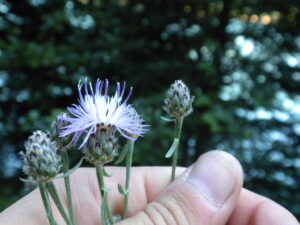
Spotted Knapweed
Spotted Knapweed (Centaurea stoebe)
Spotted knapweed is a native of Europe and Asia. It was introduced to North America in the 1890’s as a contaminant in agricultural seed and through soil discarded from ship ballasts. Spotted knapweed has many negative impacts to the landscapes it invades. For example, it releases a chemical that hinders native plants’ root growth and displaces vegetation. Also, infestations can decrease food quantities for wildlife and livestock. As well, large infestations can increase erosion and runoff. Spotted knapweed is not very common in the North Santiam Watershed.
Treatments: You can hand pull or dig up individual plants, making sure to remove as much root as possible. Plants in sandy soil pull easily, but those in hard packed soil will require a shovel or stout trowel. Sites where plants have been pulled need to be watched closely for new knapweed plants, as disturbed soil aids in germination of any seeds present.
Knapweed that is periodically mowed will generally continue to flower and produce seeds, so mowing alone is not recommended. Herbicides can be effective at the time of stem elongation (usually late April to early May), before flowers open. Remember to follow the product label and all laws and regulations regarding herbicide use on the site. Double-check the label for any site-specific restrictions.
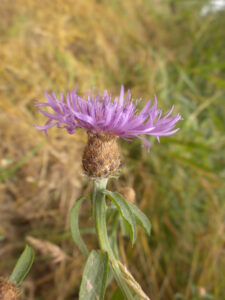
Meadow Knapweed
Meadow Knapweed (Centaurea x moncktonii)
Meadow knapweed, from Europe, is a hybrid of black and brown knapweed. It invades pastures, parks, lawns, industrial sites, tree farms, vacant lands, railroads and roadsides. Its foliage is coarse and tough and not generally palatable to livestock. Meadow knapweed out-competes grasses and other pasture species and is difficult to control. It threatens wildlife habitat and causes problems for Christmas tree growers. Meadow knapweed is the most common knapweed found in the North Santiam Watershed.
Treatments: Roto‐tilling or plowing will eliminate knapweed. Cultivating with a disk will control young plants and seedlings, but established plants can survive if the root or root fragments remain. Mowing will not control knapweed effectively. If using herbicides, the timing of application is critical to success. Meadow knapweed should be sprayed with selective herbicides between the time when the rosettes of lower leaves are actively growing until the plant reaches the bud stage (usually April – May). Remember to follow the product label and all laws and regulations regarding herbicide use on the site.
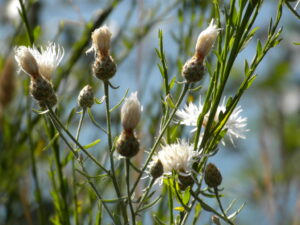 Diffuse Knapweed
Diffuse Knapweed
Diffuse Knapweed (Centaurea diffusa)
Diffuse knapweed is a European plant introduced to North America by accident. It threatens wildlife habitat and rangeland and impacts Christmas tree growers. Knapweed outbreaks in pasture and range areas cause significant losses by reducing the available forage for grazing. This plant is only known in a few isolated locations in the North Santiam Watershed.
Treatments: Individual plants can be pulled or dug up. There is usually a large seed bank so continued monitoring and removal of new plants is essential. Herbicide control is most effective in the rosette stage (April-May). Mowing may cause increased plant growth.
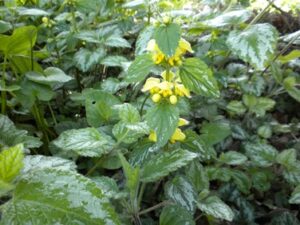
Yellow Archangel
Yellow Archangel (Lamium galeobdolon)
Yellow archangel is a fast-growing perennial ground cover that may be either trailing or upright depending on conditions. Yellow archangel, also known as yellow Lamium, is very competitive and fast-growing in the forest habitats. When it is dumped with yard waste or escapes from intentional plantings, it spreads quickly into forested areas and out-competes native understory plants. Before this plant was designated as a noxious weed in Oregon it was commonly sold at nurseries and used in hanging baskets because of its trailing growth habit.
Prevention: If you already have this plant and would like to minimize its invasive nature, contain it in flower beds by regular trimming, or dig it up and replant into pots. Because yellow archangel spreads readily by stem cuttings, it is very important to discard plant material.
Treatments: Roots are not deep so plants can be hand-pulled or dug up. This method can be labor intensive. Herbicides can be effective on yellow archangel, especially if combined with manual control and monitoring for surviving plants. Take care to avoid native vegetation by selectively spot-spraying. Remember to follow the product label and all laws and regulations regarding herbicide use on the site.
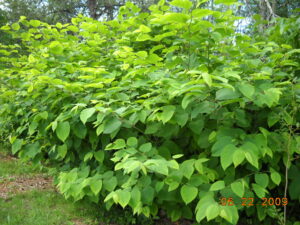 Knotweeds
Knotweeds
Knotweeds (Polygonum & Fallopia spp)
Knotweed forms dense thickets, shading out native plants and excluding native animals. It out-competes with nearby vegetation for soil nutrients and light. Additionally, it decreases property values from the potential of asphalt, concrete, or foundation damage from the rhizome and the long-term investment in the management of the plants. Lastly, it can induce bank erosion and lower water quality.
Treatments: Knotweeds are generally difficult to control and require several years of repeated cutting and herbicide treatments. If cutting small infestations, be sure to bag cut material and put in the trash, do not compost or leave on the ground. Digging is not effective. Treat foliage with herbicide in late summer or early fall after flowering.
Contact Information: For more information on the identification and treatment of the above species please contact Sarah Hamilton, with the Marion Soil & Water Conservation District (503) 949-6832 sarah.hamilton@marionswcd.net or reach out to the North Santiam Watershed Council staff at (503) 930-8202 council@northsantiam.org.
20
